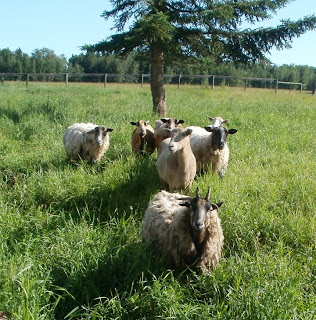Not long ago a Llama could command thousands of dollars at a sale in North America, now a knowledgeable buyer can pick one up for under $10. I have even seen people pay to have them taken away.
What was once suppose to be a bottomless market hit bottom, and today, although a few people do still raise them for fiber, one of the main uses of Llamas is to guard other livestock, such as sheep and goats.
Tips on getting a Llama to guard your livestock.
- Get one that is friendly, and ideally halter trained.
- Get only one – that way it will stay with your livestock, if you get more than one they form their own herd and do their own thing.
- An intact male Llama can be mean to your other animals, a gelded male, or female will be much better.
- Buy a Llama with a low quality fleece, that way you do not have to worry about shearing it.
- Buy a Llama that has been raised with sheep or goats.
 |
| You can tell she is not letting anything near this Jabob lamb. |
How do Llamas Protect Sheep and Goats?
Being tall makes it easy for a Llama to see a predator approaching. They tend to be slightly more observant than sheep. When alerted to something new, or out of they usual, a curious Llama will typically approach the intruder. In the case of a coyote, who is not use to being approached in this way, they will usually turn and leave, a fox (more interested in your chickens than your sheep) might be equally confused. A single feral dog might turn and leave at this “threatening” move by your guard animal, who may simply only be curious.
By being observant, bold, and curious, the Llama, often scares away the intruder. If the predator does get close the Llama may try to spit at it (they have foul smelling spit, more likely to deter a human than an hungry predator), or kick.
This year I witnessed a coyote in the neighbors pasture. The sheep were grazing in tall grass and did not see it, but the Llama did, she started walking towards it, simply looking curious and not aggressive. The coyote fled. Coyotes are not use to animals walking towards them, it found this intimidating and decided there was easier food elsewhere. I am aware that our llama would have been no match against a hungry pack of coyotes.
All in all Llamas are a fair, to good, defense against the occasional predator, however if you want tougher protection you might also want to add a donkey to your herd.
Llama versus Guard Dog?
I have not used a guard dog, and only have one llama, and one donkey for our small flock of sheep. A dog requires dog food, and as such are much more expensive to feed than my llama. As well any dog that is guarding sheep must be properly vaccinated, and protected againsts diseases. Another fact worth remembering is that llamas do not like dogs - if you introduce a guard dog, or pet dog, your llama might hurt it, so keep introductions slow, and safe!
Only certain breeds of dog work well for guarding sheep, some (such as the Border Collie) will chase the sheep too much. Some people find that by keeping dogs coyotes are more likely to come around, either attracted by a female in heat, or because they see the dog as an intruder in their area.







